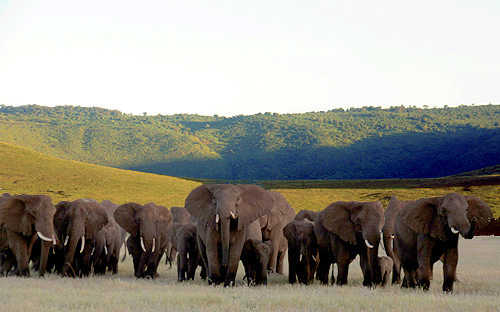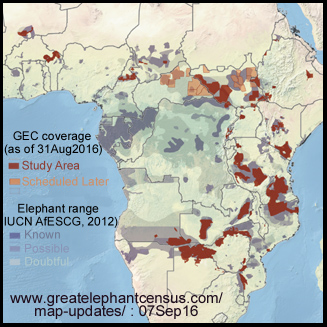 Last Wednesday the Great Elephant Census was released, documenting a major decline in elephant populations in the study area over the last decade.
Last Wednesday the Great Elephant Census was released, documenting a major decline in elephant populations in the study area over the last decade.
The study is a good one, although flawed in an important respect.
More than two-thirds of the vast areas in sub-Saharan Africa in which elephants might live were not included in the study1. To the study’s credit it showed these areas directly below its survey map. I believe that once these areas are adequately surveyed, the decline in elephants will prove less dramatic than currently suggested.
Nevertheless, I believe that the overall decline in elephants is serious although no more than the decline in lions and neither reaches the “near-extinct-in-the-wild” situation of animals like the black rhino.
How does poaching fit into all of this? Read the GEC and many other studies carefully, and you’ll note that field scientists almost universally believe that habitat erosion is as great if not greater a factor in elephant decline than poaching.
Habitat erosion can come from climate change or building cement factories or staking out ranches. Human/wildlife conflict is the central issue to the decline of elephants, not poaching.
Poaching is an emotive issue, great for raising funds. Human/wildlife conflict is cerebral and cumbersome, not great for raising funds. It annoys the hell out of me that well thinking individuals can be galvanized into action for “poaching” without truly understanding what is going on.
As I’ve often written poaching today in Africa is completely different from the corporate poaching of the middle of the last century when it was first elevated into the public consciousness. I consider it less criminal and here’s why:
In the last century large corporate organizations harvested tens of thousands of elephant in well-planned often high-tech operations. The organizers were often self-funded and were often the actual poachers. They were villains to be sure, illegally crossing borders and feeding greedy consumption markets, enriching their already rich selves.
Today the villains have been marginalized into the middle men facilitating illegal market conduits, usually disreputable foreigners bribing local police and customs. The actual poachers in marked contrast to before are often one-off gangs, small groups of youth who have no other prospects for income.
You see where I’m going. The poor sops trying to kill an elephant today, and often getting killed by the elephant instead, would absolutely prefer being paid to sweep the streets. There are so many unemployed and educated, so many desperate that this remote jungle crime can be quite enticing. The chances for capture are less than in the city and the booty usually far greater.
That doesn’t justify it, just as robbing a bank in Dar-es-Salaam isn’t justified, either, by the poverty of the desperados. But it should shine a new light on the problem. I think we should begin to bundle “poaching” into the more correct explanation for elephant decline, “human/wildlife conflict.”
My view remains that in many of the parts of Africa in which I guide safaris there are too many elephant. This is not a contradiction with my embrace of the GEC, nor should you infer from this that I condone any reason for elephant declining.
As habitat shrinks elephant feel the squeeze. Their behavior has grown more aggressive and aberrant. Elephant are more dangerous today than they used to be. That doesn’t just mean we take more care with tourists, it means they plunder farm fields more regularly and with greater abandon.
As Africa develops so rapidly – especially and particularly those areas which until very recently were sparsely populated wildlife savannas and forests – human/wildlife competition grows intense. African people – as you would suppose and I hope would also support – are on the whole dominating this struggle. But how they win it, and how well they can simultaneously conserve their environment is integral to their own future.
Sub-Saharan Africans need only refer to two different global models for guidance. Having very poorly conserved their environment the Malagasy people find themselves today suffering constant economic recessions and growing political turbulence. In contrast many Amazonia nations – Brazil especially – are winning the conservation battles and despite the current political setback in Brazil today, the region is generally much better off economically and socially than Madagascar.
There are so many factors involved in whether a society is healthy or not, it’s impossible for me to connect these dots in this short post, but it’s something I fervently believe. Until mankind becomes significantly more clever and skilled than we currently seem capable of ever becoming, the health of our environment and biomass will reflect our own social, economic and political progress.
China will best put this to the test, likely in all our life times, and that jury remains out. Yet it is encouraging to learn today that pandas have been taken off the endangered list.
At its most fundamental and critical core, the elephant decline is no different from the lion decline or the whole issue central to wildlife conservation in Africa: the human/wildlife conflict. Good people get caught up in bad people’s exploitations. The solution doesn’t lie in stopping poaching. It lies in bringing prosperity to the African people.
* * *
 1 For GEC’s first time around, the census was restricted to areas that had some previous baseline research and active NGO involvement. This was wise. Not only could the concluding comparisons be made, but assistance in the actual count provided by experienced NGOs was invaluable. Almost all the areas, therefore, included in the study were government protected, areas like gazetted national parks and reserves. Extending the survey as is planned to the other areas will be challenging. Much of these areas include privately owned land and virtually all of them have had little or no active previous field research. Nevertheless this is a major sticking point for me. There aren’t really many prepared right now to speculate on the numbers of elephant in these areas, and I for one believe that as human/elephant conflict increases, elephant will increasingly flee to these areas.
1 For GEC’s first time around, the census was restricted to areas that had some previous baseline research and active NGO involvement. This was wise. Not only could the concluding comparisons be made, but assistance in the actual count provided by experienced NGOs was invaluable. Almost all the areas, therefore, included in the study were government protected, areas like gazetted national parks and reserves. Extending the survey as is planned to the other areas will be challenging. Much of these areas include privately owned land and virtually all of them have had little or no active previous field research. Nevertheless this is a major sticking point for me. There aren’t really many prepared right now to speculate on the numbers of elephant in these areas, and I for one believe that as human/elephant conflict increases, elephant will increasingly flee to these areas.
But isn’t prosperity going to further decrease and degrade wildlife habitat? Just like what’s happening here…
Approximately 40 000 elephants a year for the past two to three years have been poached from Tanzanian parks alone. I am glad to read that you guide in areas where there are too many elephant.. This might be a factor of guiding in the most popular parks where tourist activity discourages poaching. In parks, less accessible, less traversed and less policed you’ll find that there aren’t nearly enough elephant to balance the ecosystem.
I don’t disagree that prosperity is a factor, I do however believe that greater than that is the consumption of ivory, which until addressed will continue to cause poaching in a prosperous or not environment.